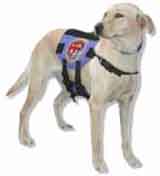Dog Behavior Problems and TrainingHow To Remain Safe And Calm Around Strange Or Aggressive Dogs |
|
|
A knowledge of canine body language can protect you and your children around strange or threatening dogs. If you understand how the animal will interpret your body movements and facial expressions, you will know how to act in a nonthreatening way and avoid a possible aggressive attack. Here are a few rules to follow: 1. Never approach an unknown dog without first asking its owner if it's all right. If the owner is not around, don't approach the dog. 2. Never run up to a dog, or make quick, jerky gestures toward it that might be interpreted as a threat. Move slowly and deliberately. 3. Many people immediately squat down to be at a dog's eye level. Don't do this. Staring into a strange dog's eyes may be considered a challenge by the dog; an invitation to fight. If you get down low, you're telling the dog, "Look, I'm submissive to you." 4. When you meet a dog for the first time, make your hand into a loosely closed fist, fingers down, and extend it slowly to allow the dog to sniff your knuckles. Never put your open hand over the dog's head as if to pat it, because this is interpreted as a threat by many dogs. If the dog is calm and friendly, you can then turn your hand over, palm up, but continue to keep your fingers curled in lightly; then you can gradually uncurl your fingers and let the animal nuzzle your hand if it wants to. 5. If a strange dog approaches you, stay still. If you're standing, put your arms at your sides. Don't raise your arms as the dog may think that you are threatening it. If you're on the ground, lie face-down. Let the animal sniff at you - soon it will lose interest and go away. 6. Adults should never snatch a small child away or up from a dog, because the animal may then perceive the child as a toy; a stuffed animal to run and grab. If an adult calmly places herself between the child and the dog, the dog will understand that she's being protective, and that's pack-related behavior. 7. Running away is interpreted by a dog as flight behavior and almost always triggers an instinctive chase reaction in a dog, in which it sees you, the runner, as potential prey. To sum up, stay calm and use common sense around any dog. It will understand by your reactions and body language that you are not a threat and will leave you alone.Back to the Dog Behavior Problems and Training page
| |
|
Related News About Dogs ' ); // get rid of newsfeed display by carp CarpConf('poweredby',''); CarpCacheShow('http://dogguidance.com/dogblog/?feed=rss2'); ?>
|
|
|
|
|
|
Copyright © 2006-2007 dogguidance.com |


